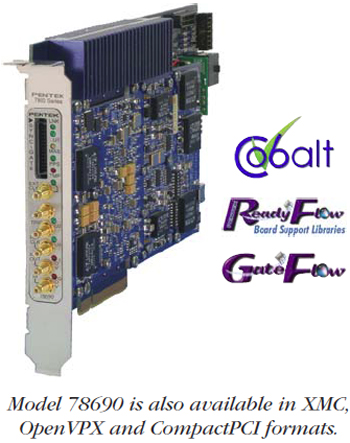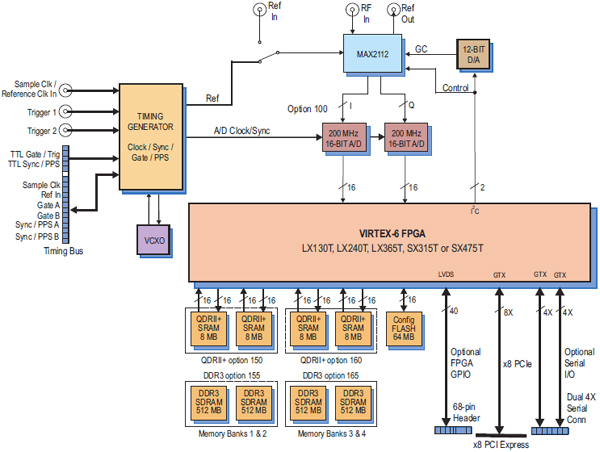L-Band RF Tuner with 2-Channel 200 MHz 16-bit A/Ds and Virtex-6 FPGA - x8 PCIe
|
Features
- Accepts RF signals from 925 MHz to 2175 MHz
- Programmable LNA boosts LNB (lownoise block) antenna signal levels with up to 60 dB gain
- Programmable analog downconverter provides I + Q baseband signals with bandwidths from 4 to 40 MHz
- Two 200 MHz 16-bit A/Ds
- Supports Virtex-6 LXT and SXT FPGAs
- 2 GB of DDR3 SDRAM or 32 MB of QDRII+ SRAM
- Sample clock synchronization to an external system reference
- PCI Express (Gen. 1 & 2) interface, up to x8
| |

|
Model 78690 General Information
The Model 78690 is a member of the Cobalt® family of high performance PCIe boards based on the Xilinx Virtex-6 FPGA. A 2-Channel high-speed data converter, it is suitable for connection directly to the RF port of a communications or radar system. Its built-in data capture features offer an ideal turnkey solution.
It includes an L-Band RF tuner, two A/Ds and four banks of memory. In addition to supporting PCI Express Gen. 2 as a native interface, the Model 78690 includes general purpose and gigabit serial connectors for application-specific I/O.
The Cobalt Architecture
The Pentek Cobalt Architecture features a Virtex-6 FPGA. All of the board’s data and control paths are accessible by the FPGA, enabling factory-installed functions including data multiplexing, channel selection, data packing, gating, triggering and memory control. The Cobalt Architecture organizes the FPGA as a container for data processing applications where each function exists as an intellectual property (IP) module.
Each member of the Cobalt family is delivered with factory-installed applications ideally matched to the board’s analog interfaces. The 78690 factory-installed functions include two A/D acquisition IP modules.
IP modules for either DDR3 or QDRII+ memories, a controller for all data clocking and synchronization functions, a test signal generator, and a PCIe interface complete the factory-installed functions and enable the 78690 to operate as a complete turnkey solution without the need to develop any FPGA IP.
RF Tuner Stage
A front panel SSMC connector accepts L-Band signals between 925 MHz and 2175 MHz from an antenna LNB (low noise block). A Maxim MAX2112 tuner directly converts these L-Band signals to baseband using a broadband I/Q downconverter.
The device includes an RF variable-gain LNA (low noise amplifier), a PLL (phaselocked loop) synthesized local oscillator, quadrature (I + Q) downconverting mixers, baseband lowpass filters with programmable cutoff frequency, and variable-gain baseband amplifiers.
The fractional-N PLL synthesizer locks its VCO to the timing generator output, or to an external reference input between 12 and 30 MHz. Together, the baseband amplifiers and the RF LNA offer a programmable linear gain range of 60 dB.
An integrated lowpass filter with variable bandwidth provides bandwidths ranging from 4 to 40 MHz, programmable with 8 bits of resolution.
For more information and a price quotation on the Model 78690, click here.
| 



